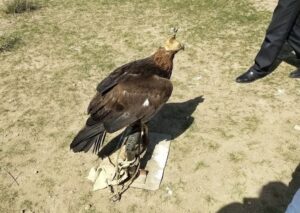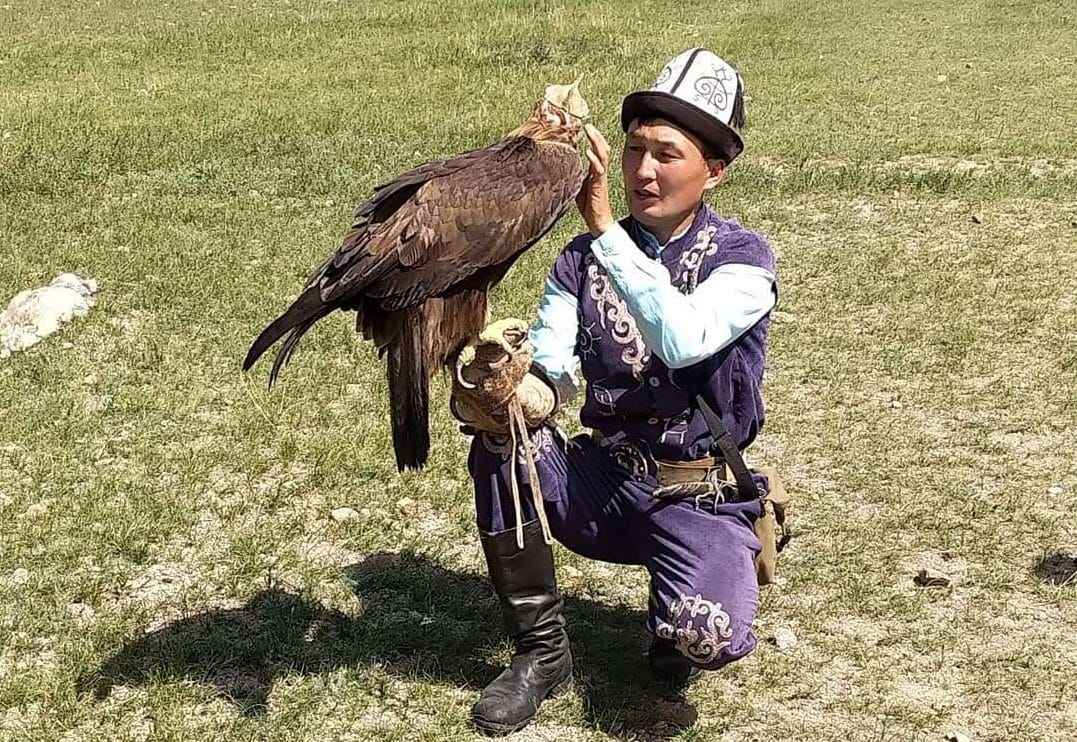SRAS students studying abroad in Bishkek, Kyrgyzstan on the Central Asian Studies Porgram often have the opportunity to visit Lake Issyk-Kul as part of their program abroad. This semester, the local excursions into the surrounding mountains included a presentation on local traditions surrounding eagle training.
Golden eagles have been used for hunting in Kyrgyzstan for centuries. Our presenter, a local Kyrgyz man, told us that at the dawn a humanity, a properly trained hunting bird was the greatest ally a man could find. Golden eagles have historically helped Kyrgyz villages to be protected from wolves, and to have meat and skins for food and warm clothes.

The man told us about eagle training and the difference between how they hunt for humans versus how they behave in the wild. For instance, eagles in the wild do not learn to hunt the skin of an animal, but rather, only animals. When a trainer trains an eagle, the eagle instead learns to hunt both skins and live animals. It also seldom gets the chance to eat the whole animal it catches like it would in the wild. When it comes to selecting an eagle to train, a trainer will monitor its parents in the natural world to find an eagle that they consider to be easily trainable.
In order to train the eagles, it is best that they are taken from the wild as young as possible. An eagle’s age can be roughly discerned from its feathers. Eagles young enough to train need to have at least some white feathers in their tail. Ideally, eagles are ideally trained between infancy and the time they are five years old. The two eagles that were a part of our presentation were about six and seven years old. In the instance of the one eagle in this demonstration, it was taken from the nest as a chick.
When they are ten and fifteen years old, they should be released back to the wild as these are their reproductive years. This practice is, in part, responsible for the stable golden eagle population in the Ala-Tao mountain region. While golden eagles can live for up to fifty years in captivity, eagle trainers never keep them for that long.
Although eagles are wild animals, they work well with humans. The presenter said that eagles find the human voice soothing. Therefore, it is important to regularly talk to them, especially when training them.
When training an eagle, they are first trained using animal skins, such as rabbit pelts. We saw a demonstration of this in which the eagle was taken by the assistant and moved some distance away. The presenter then ran with the skin down near where we were standing. The eagle soared down and around, catching the skin from behind. Eagles always attack an animal from behind because they cannot dive and thus must soar down to catch its prey. Whenever the eagle catches the skin in training, it is rewarded with meat.
The next step is using a live animal, but then taking the live animal away and giving the animal meat to eat instead. We next saw a demonstration of this during which the eagle caught a live rabbit. The eagle was taken further away than before. The rabbit was released, and stood still for a while. The eagle stood still as eagles can’t see their prey unless it’s moving. The assistant threw a rock at the rabbit to scare it. Once it moved, the eagle finally saw it, swooped down, and got him. This part was a little gruesome to watch. The eagle expanded its wings around the dead rabbit, suffocating it and biting it until it was dead, or, in other words, eating it alive. It began by eating its head. The presenter than took the rabbit from the eagle.

The golden eagles are held by a glove with a strong, attached rope about five feet long. This came in handy when the eagle flew back towards the dead rabbit that had been taken from it. He was immediately given more meat to both distract him and continue his training. The assistant then bagged the dead rabbit in the same bag it was brought out in and took it away. The eagle was also given it’s “hat” – which covers its eyes and prevents it from unnecessarily hunting any nearby animals – or attempting to retrieve the prey taken from it. Unable to see the rabbit it therefor gave up on trying to eat it.
In addition to eagle training, we learned more about the golden eagle in general. It is a strong bird with relatively sharp claws that grow more easily when soaked in water. Eagle trainers will do this, especially in the instance that the eagle has broken a nail while hunting. The claws cover nails underneath. Its grip is very strong, making it easy for them to perch on a human. The eagle was also trained so that if you twisted your arm back slightly, it would span its feathers. The purpose of this is mostly to show off this trick when putting on eagle performances, such as the one we attended.
We learned that eagles are powerful and versatile hunters. In addition to rabbits and wolves, golden eagles also hunt foxes and young deer.
When it came time for us students to take a picture holding one of the eagles, it was then that we each realized their full physical weight. They were about 5 kg (about 11 pounds) each, which was considered “small.” Big eagles can weigh up to 10 kg. Since the eagles are accustomed to humans, the eagle did not try fly away while each student took turns holding it.
Golden eagles remain a beloved animal amongst Kyrgyz nationals. Our presenter told us that no citizen would ever want to harm an eagle, as it remains the national emblem and winged symbol of Kyrgyzstan.





